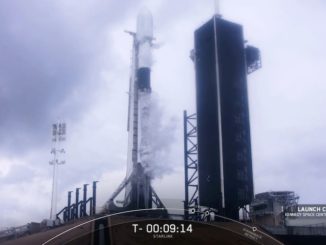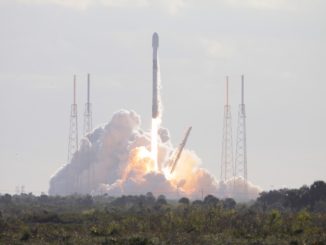EDITOR’S NOTE: Updated at 7:30 p.m. EDT (2330 GMT).
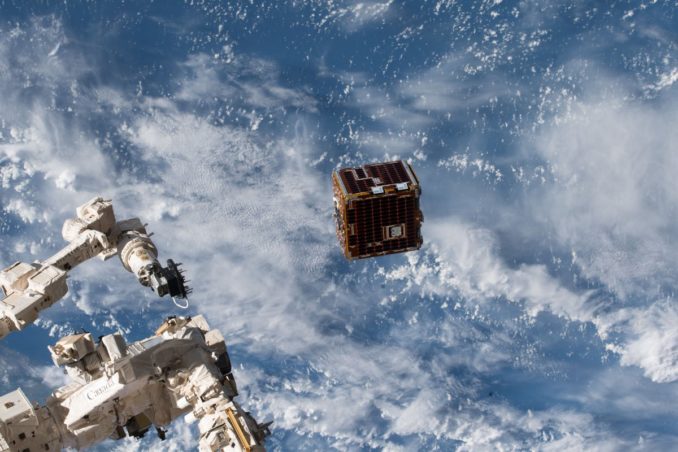
A small satellite assembled in Britain has been released from the International Space Station, commencing a standalone mission to test technology and techniques that could be used to capture and de-orbit space junk in low Earth orbit.
Loaded with experiments crafted by engineers across Europe, the RemoveDebris spacecraft has powered up and is undergoing checkouts after its deployment June 20 from the space station’s Canadian robotic arm.
The cube-shaped spacecraft measures about 3 feet (1 meter) on each side, and weighed about 220 pounds (100 kilograms when it launched April 2 from Cape Canaveral inside a SpaceX Dragon supply ship.
Soon after the resupply mission’s arrival at the space station April 4, astronauts transferred the RemoveDebris satellite from the Dragon capsule’s cargo compartment into the Japanese Kibo lab module. The station’s crew removed shields used to protect the spacecraft during launch, then placed it on a sliding tray inside the Kibo lab’s airlock.
The spacecraft transferred through the airlock to the Japanese lab’s outside science deck, where the robotic arm grabbed it and move to a predetermined position for release June 20 from the Kaber microsatellite deployer, a device developed and owned by Houston-based NanoRacks.
RemoveDebris was the largest satellite deployed from the International Space Station to date, following scores of CubeSats and a pair of microsatellites — both smaller than RemoveDebris — which used the Kaber mechanism last year.
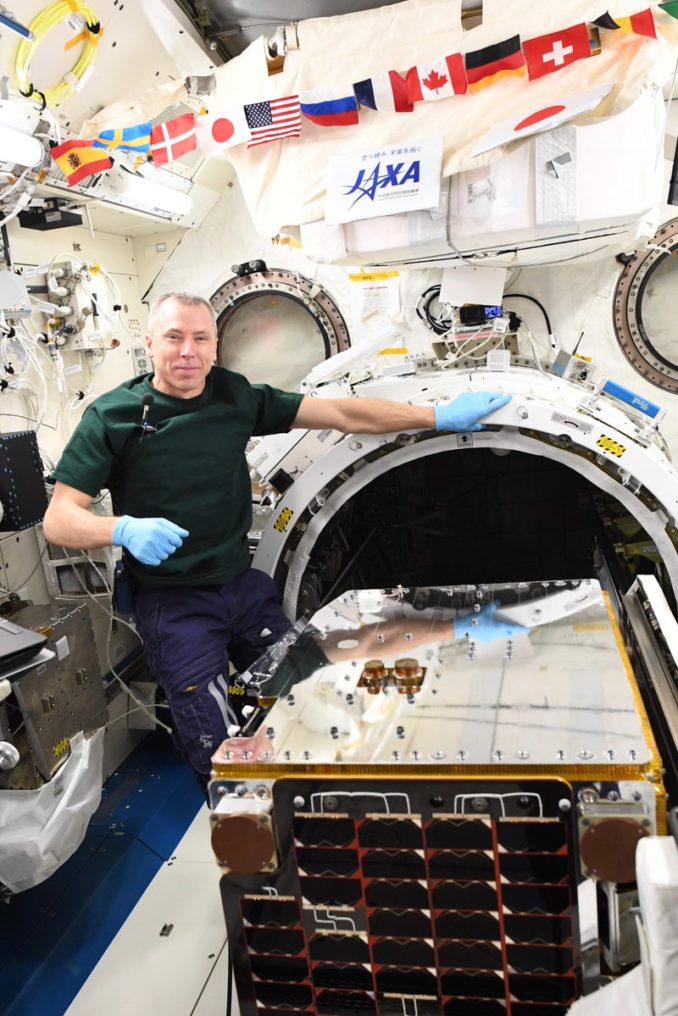
Developed in a public-private partnership, the RemoveDebris mission will test the utility of nets and harpoons to capture tumbling objects in orbit, repurposing devices commonly used in fishing to pluck debris out of orbit and bring them into Earth’s atmosphere to burn up.
In an interview before the launch of RemoveDebris in April, Guglielmo Aglietti, principal investigator for the RemoveDebris mission, called the project a “proof-of-concept.”
They crux of the mission, Aglietti told Spaceflight Now, is to prove that cleaning up space junk can be relatively inexpensive — something that could be affordable by commercial companies, or governments operating under budget limitations.
“After almost five years of development, it is exciting to finally be in a position where we can test these extremely exciting technologies in the field,” said Aglietti, director of the Surrey Space Center, a research institute affiliated with the University of Surrey and Surrey Satellite Technology Ltd., a British manufacturer of small satellites.
“If successful, the technologies found in RemoveDebris could be included in other missions in the very near future,” Aglietti said in a statement following the satellite’s deployment from the space station.
The RemoveDebris satellite, built by SSTL in the United Kingdom, punches above its weight. The RemoveDebris mothership contains two CubeSats, a net and a harpoon, a laser ranging instrument, and a “dragsail” designed to unfurl behind the main satellite and hasten its fall back into Earth’s atmosphere using aerodynamic resistance.
“It’s wonderful to have helped facilitate this ground-breaking mission,” said Conor Brown, NanoRacks external payloads manager, in a statement. “RemoveDebris is demonstrating some extremely exciting active debris removal technologies that could have a major impact to how we manage space debris moving forward.
“This program is an excellent example of how small satellite capabilities have grown and how the space station can serve as a platform for missions of this scale. We’re all excited to see the results of the experiments and impact this project may have in the coming years,” Brown said.
Ground controllers at SSTL’s campus in Guildford, England, will put the RemoveDebris spacecraft through four primary experiments.
“Basically, it has a net, a harpoon and a dragsail on-board,” said Jason Forshaw, the RemoveDebris mission’s former project manager at SSTL. “The concept is it’s going to go up there, and it’s going to eject small little satellites that will be used as artificial space junk.”
One of the CubeSats, about the size of a loaf of bread, will inflate a balloon to mimic the dimensions of a bigger piece of tumbling space junk. Flying a short distance away, RemoveDebris will release a net from a distance of around 23 feet (7 meters) to envelop the CubeSat — named DebrisSat 1 — which will be cut loose to re-enter the Earth’s atmosphere.
“The net, as a way to capture debris, is a very flexible option because even if the debris is spinning, or has got an irregular shape, to capture it with a net is relatively low-risk compared to … going with a robotic arm, because if the debris is spinning very fast, and you try to capture it with a robotic arm, then clearly there is a problem,” Aglietti said. “In addition, if you are to capture the debris with a robotic arm or a gripper, you need somewhere you can grab hold of your piece of debris without breaking off just a chunk of it.”
The net experiment is currently scheduled for September, according to Airbus Defense and Space, which developed the net at its facility in Bremen, Germany.
“We’ll have a CubeSat which is released, a large target being inflated, and then the net ejected and wrapping itself around the target, and bringing the whole lot home, all videoed by RemoveDebris,” said Simon Fellows, project manager for the RemoveDebris mission.
Another CubeSat, named DebrisSat 2, will separate from the RemoveDebris mothership in October to test out tracking and ranging lasers and algorithms. The RemoveDebris satellite will use DebrisSat 2 to test out close-up vision-based navigation technology needed for an orbiting garbage collector to approach an out-of-control piece of space junk.
The LIDAR instrument “can observe debris, and figure out all the parameters of what this debris is doing in order to plan your capture,” Aglietti said. “We have a normal camera, and then a LIDAR, which uses lasers to illuminate the object and figure out what the object is doing, and try to quantify the parameters, not just looking and seeing it, but also trying to see the spin rate, for example.”
The DebrisSat 2 craft will transmit its true position back to the RemoveDebris mothership, allowing engineers to evaluate the performance of the navigation cameras and laser systems provided by Airbus teams in Toulouse, France.
“The vision-based navigation experiment will actually see debris and work out how it’s moving, and how best to then deal with the debris,” Fellows said.
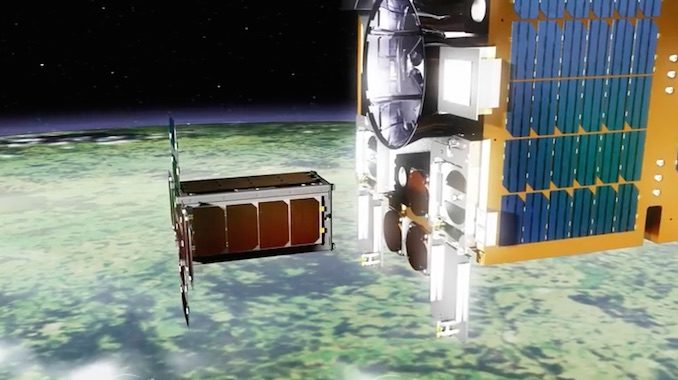
The third RemoveDebris experiment, set for next March, will test the functionality of a harpoon, which would be used to fire at a dead satellite and spear it, allowing the junk to be maneuvered out of orbit for a fiery re-entry.
But RemoveDebris will not test the harpoon on an actual satellite. The technology is still untried in space, and there are legal concerns about using it to lasso someone else’s spacecraft without permission.
“Maybe it’s a bit more risky because you have to hit your debris in a place that is suitable to be captured by the harpoon,” Aglietti said. “Clearly, you have to avoid any fuel tanks … That would produce some undesired effects.”
Instead, RemoveDebris will extend an arm with a target for the harpoon on the end, then fire the projectile on a tether at a velocity of around 45 mph, or 20 meters per second. The harpoon experiment is spearheaded by Airbus engineers based in Stevenage, England.
“One of the main things we aim to learn from this is how things behave and move in zero gravity and and in a zero-air environment,” Fellows said. “It’s very difficult to test a tether with a harpoon on the ground, and the best way to really test it is in the space environment.”
“We have harpoons, we have nets,” Forshaw said in a TEDx talk last year. “These all seem like simple concepts, and they are. They’ve been used for thousands of years underwater to capture things such as sea creatures. However, taking technologies that are mature on Earth, in the oceans, and actually bringing them up there into space and seeing (if) these concepts work for the first time — nobody has ever used a net or a harpoon for these purposes in space before.”
Finally, RemoveDebris will open up an expandable sail to act like an airbrake or spoiler, generating drag from collisions with air molecules in the rarefied outer atmosphere. At the space station’s altitude of around 250 miles (400 kilometers), the dragsail will bring the RemoveDebris satellite back into the denser layers of the atmosphere, where it will burn up.
The braking mechanism will allow RemoveDebris to re-enter the atmosphere within about eight weeks of unfurling the dragsail, not the estimated two-and-a-half years it would take to de-orbit naturally.
“All the elements of the mission should be de-orbited very quickly,” Aglietti said. “Clearly, for a mission like ours, we don’t to further contribute to the problem of space debris. We want to make sure that all the pieces we are putting up there are going to come down pretty quickly. For us, a launch from the International Space Station is particularly good because it’s in such a low orbit, that in any case, even if some of the experiments do not work out as planned, it doesn’t matter because everything is going to come down and burn up in the atmosphere.”
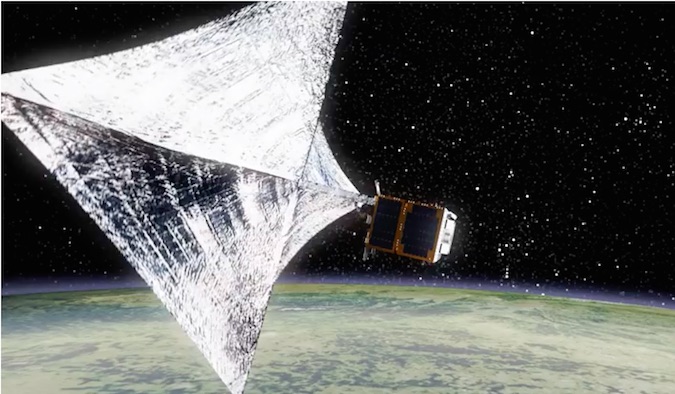
Budgeted at 15.2 million euros — $17.7 million at today’s currency exchange rates — the RemoveDebris mission was partially funded by the European Commission. The rest of the project was paid by the 10 companies involved in the demonstration, including SSTL, Airbus Defense and Space, and Ariane Group.
Experts currently estimate nearly 7,000 tons of junk and debris are orbiting Earth, a mass equivalent to the Eiffel Tower.
“SSTL’s expertise in designing and building low-cost, small satellite missions has been fundamental to the success of RemoveDebris, a landmark technology demonstrator for active debris removal missions that will begin a new era of space junk clearance in Earth’s orbit,” said Martin Sweeting, SSTL’s executive chairman, in a statement.
In-space collisions have happened before.
In 2009, a commercial Iridium communications satellite collided with a deactivated Russian military craft, destroying both objects and creating thousands more pieces of space junk.
“Satellites that get old also have residual fuels on them,” Forshaw said. “Sometimes these fuels mix, so satellites are remarkably good at exploding by themselves.”
“One of the core questions is who is responsible for all of this,” Forshaw said. “Who is responsible for keeping space tidy? There, space law is complicated. Every single item in space, whether it be a full satellite or a piece of glass, is actually owned by somebody. You can’t take away their property without their permission. Besides, if a tiny little fragment hit your satellite, you wouldn’t even know who did it.”
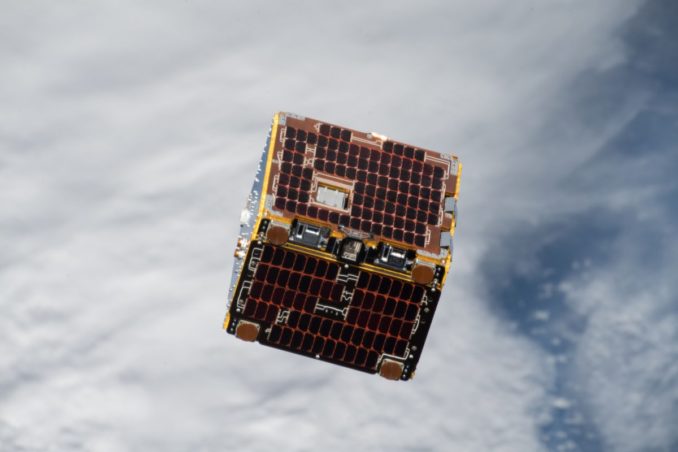
As companies like OneWeb, SpaceX and others build out planned “mega-constellations” of hundreds and thousands of communications satellites, the space debris problem will remain top of mind for many in the industry.
OneWeb and SpaceX say they will steer their planned broadband communications satellites back into Earth’s atmosphere once their missions are complete, but some of the spacecraft could become stranded if they suffer unexpected failures.
“There are really two solutions: Either we ensure things launched into space have the ability to come back down themselves, and/or we launch missions up there to actually capture some of this space junk and bring it back down to Earth, where it will burn up in the Earth’s atmosphere,” Forshaw said.
“Once the whole campaign is finished, and the (RemoveDebris) satellite is de-orbited, it would be great if companies offered this as a service, and there will be bigger missions when they will go and capture a real piece of debris using some of the technologies we have demonstrated,” Aglietti said.
One company established to remove space debris out of orbit is Astroscale, headquartered in Singapore. Astroscale is developing a commercial space debris capture experiment in partnership with SSTL. After overseeing the design and construction of the RemoveDebris satellite, Forshaw joined Astroscale as manager of the company’s European research and development efforts.
The European Space Agency also has a mission concept called e.Deorbit, which would launch in 2024 to rendezvous with Envisat, a defunct Earth observation satellite that failed suddenly in 2012. Envisat is the size of a double-decker bus, and experts anticipate it will remain in space for up to 150 years, posing a hazard to other satellites in the same region of space nearly 500 miles (800 kilometers) above Earth.
The e.Deorbit mission, if approved by ESA member states, would bring Envisat down in a controlled manner. The RemoveDebris mission will check to see if some of the fundamental parts of such an endeavor will work.
“At the end of the day, everything boils down to funding,” Aglietti said. “We all agree, in the space sector, that it is a good idea to start to remove larger pieces of debris, which are the ones that cause the major threat. The problem is just financial.
“That was why we’re testing cost-effective technologies,” he said. “In my opinion, the stumbling block is the cost … If the cost to do it is exorbitant, then people will prefer to take the risk that their new satellite is going to be hit by a piece of debris. If we manage to lower the cost of the missions, then this is much more likely to happen.”
Email the author.
Follow Stephen Clark on Twitter: @StephenClark1.

